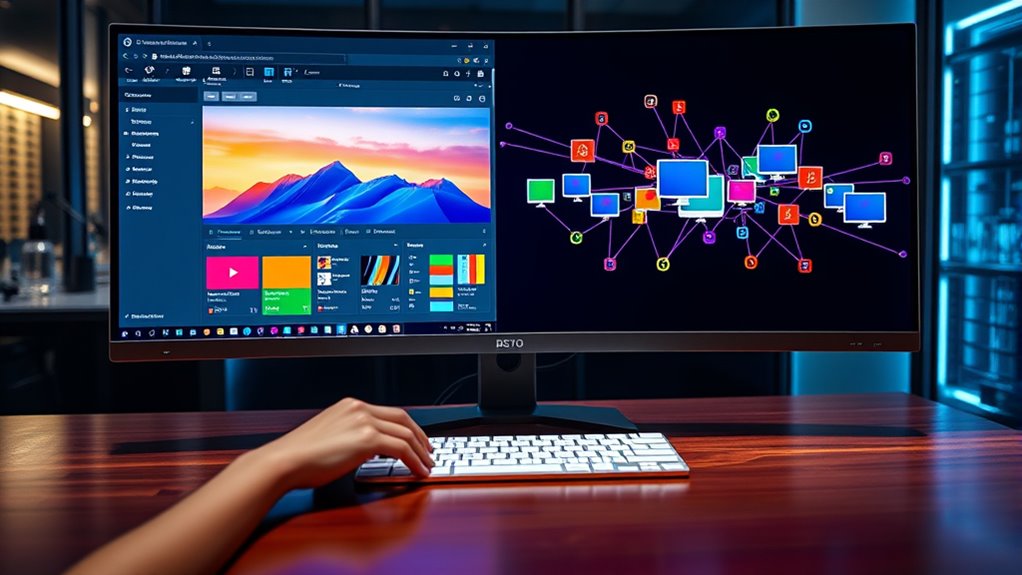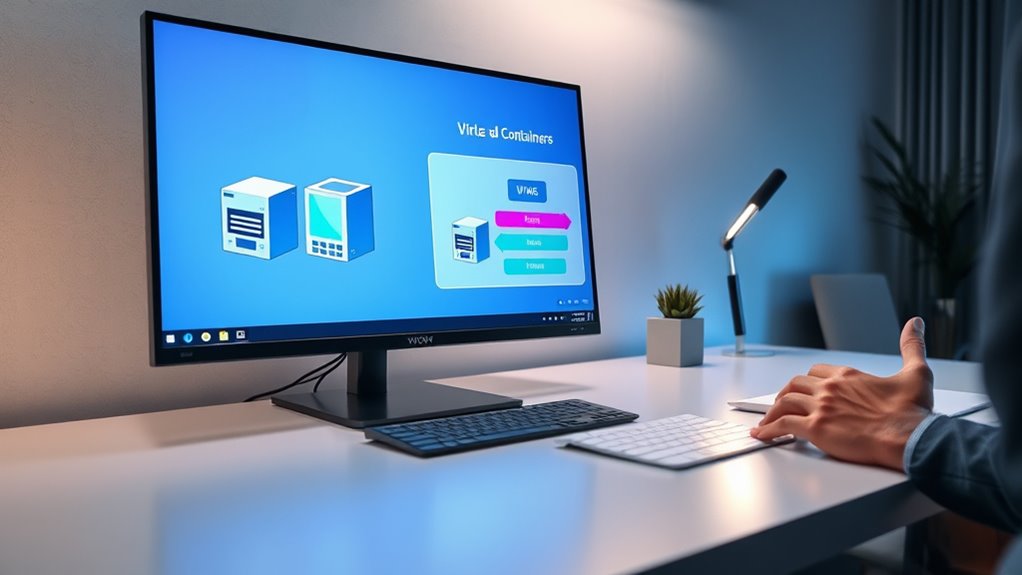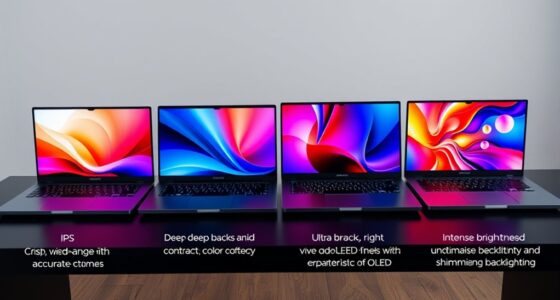For personal desktop virtualization, virtual machines offer strong security and compatibility by emulating complete hardware and running separate OS, but they use more resources and are slower to start. Containers are lightweight, share the host OS, and start quickly, making them efficient but less isolated. Choosing depends on your needs—if security is key, VMs work better; for speed and simplicity, containers shine. Keep exploring to find the best fit for your setup.
Key Takeaways
- VMs offer full OS emulation with strong isolation, ideal for running diverse, legacy, or proprietary applications on consumer desktops.
- Containers provide lightweight, rapid-deployment environments sharing the host OS kernel, enhancing speed and resource efficiency.
- VMs deliver better security through hardware-level separation, while containers pose higher security risks due to shared kernel vulnerabilities.
- VMs require more hardware resources and longer startup times; containers are resource-efficient with near-instant deployment.
- For ease of use and security, VMs are generally preferred for consumer desktop virtualization, despite higher resource demands.
Understanding Virtual Machines and Containers

Virtual machines (VMs) and containers are two key technologies that enable desktop virtualization, but they operate quite differently. VMs emulate entire hardware systems, running separate operating systems on top of your host machine. This provides strong isolation and broad application compatibility, but it also demands more resources like CPU, memory, and storage. Containers, on the other hand, share the host OS kernel, creating lightweight, fast-start environments. They are ideal for deploying individual applications or development workflows, offering quick startup times and lower overhead. However, containers provide less isolation compared to VMs, making them less suitable for full desktop experiences. Your choice depends on your needs: VMs for all-encompassing desktop environments, containers for streamlined, application-focused virtualization. Integration with management tools enhances deployment and orchestration capabilities for both technologies. It is also important to consider security implications, as the level of isolation impacts vulnerability management. Additionally, understanding the resource utilization differences can help optimize performance and cost-efficiency for your virtualization strategy.
Key Differences in Architecture and Functionality

Understanding the core architectural differences between virtual machines and containers is essential for choosing the right technology for your desktop virtualization needs. VMs run complete OS instances with their own kernel, hardware emulation, and dedicated resources, providing strong isolation. Containers, on the other hand, share the host OS kernel, running isolated user spaces with less overhead.
Here’s how they differ:
- Resource Usage: VMs need more system resources due to full OS duplication. Containers are lightweight, sharing resources efficiently.
- Startup Speed: VMs take longer to boot; containers start almost instantly.
- Isolation: VMs offer robust separation, making them ideal for full desktop environments. Containers are better suited for isolated apps.
- Flexibility: VMs support diverse OSes; containers are limited to the host OS but excel in rapid deployment.
Security Aspects of VMs and Containers

When considering the security aspects of desktop virtualization, it’s important to recognize that virtual machines and containers each present unique vulnerabilities. VMs offer strong isolation because they emulate hardware and run separate OS instances, making it harder for threats to spread. However, they require more resources and can be compromised if hypervisors are vulnerable. Containers share the host OS kernel, which makes them lightweight and fast but introduces security risks; a flaw in the kernel can affect all containers. Containers have a smaller attack surface but are less isolated than VMs. For consumer use, VMs provide better security due to their stronger separation, while containers demand careful management to prevent vulnerabilities from spreading across applications or the host system.
Performance and Resource Utilization

Performance and resource utilization are critical factors when choosing between virtual machines and containers for consumer desktop virtualization. Your decision impacts speed, efficiency, and hardware demands. Here’s what to take into account:
- Virtual Machines (VMs) use more resources because they run full OS instances, which can slow down your system if hardware is limited.
- Containers share the host OS kernel, making them lightweight and faster to start, perfect for quick app deployment.
- VMs provide strong isolation but require more CPU, RAM, and storage, potentially limiting performance on weaker hardware.
- Containers excel in efficiency but offer less security because they share the kernel, making them suitable for isolated app environments rather than full desktops.
- Understanding hardware requirements helps in selecting the most suitable virtualization method for your setup, especially considering the regional availability of resources, which can influence your hardware choices and performance expectations. Additionally, resource sharing among containers can lead to better utilization but may require careful management to prevent conflicts.
Balancing these factors helps optimize your desktop experience based on your hardware and needs.
Compatibility and Application Support

Choosing the right virtualization method depends heavily on the compatibility and support for your applications. Virtual machines excel here, as they fully emulate hardware and run separate operating systems, making them compatible with most software, including legacy applications. This broad compatibility guarantees that your existing tools and programs work without issues. Containers, however, share the host OS kernel, which limits support mainly to applications that can run within that environment. They’re ideal for lightweight, isolated app deployment but may struggle with complex, proprietary, or older software requiring specific OS features. If you need full OS compatibility and flexibility, VMs are the better choice. For quicker, resource-efficient app isolation and deployment, containers are suitable, provided your applications are compatible with the host OS. Additionally, understanding the hours of operation for local services can help plan your IT support and maintenance schedules effectively. Considering the application compatibility of your software stack is crucial in selecting the most suitable virtualization approach. To optimize performance and reliability, it’s important to be aware of the underlying hardware requirements that support each virtualization technology. Moreover, staying informed about emerging virtualization trends can help you adapt to evolving technology standards and improve your infrastructure’s efficiency. Being aware of the security considerations associated with each method can also aid in safeguarding your environment.
Use Cases for Consumers

Consumers use desktop virtualization to access their applications and data seamlessly across multiple devices, whether at home, in the office, or on the go. This flexibility helps you stay productive and entertained without being tied to a single machine. Here are some common use cases:
- Remote Work: Access work apps and files securely from any device, making remote collaboration easier. Being aware of common pitfalls can help avoid security vulnerabilities and technical issues.
- Gaming: Run resource-heavy games on less powerful devices by offloading processing to a virtual machine or container. High-performance suction power and filtration efficiency ensure smooth gameplay experiences.
- Development & Testing: Quickly test apps in isolated environments without affecting your main system.
- Personalized Environments: Maintain separate setups for work, personal use, or hobbies, switching effortlessly between them.
- Security and Privacy: Desktop virtualization provides security benefits by isolating sensitive data and applications from the main system.
Desktop virtualization empowers you to customize, secure, and streamline your digital life.
Ease of Deployment and Management

Deploying and managing desktop virtualization solutions has become more straightforward thanks to modern cloud-based platforms and centralized management tools. With VMs, you benefit from dedicated management consoles that simplify OS updates, security patches, and configuration. These tools allow you to deploy new virtual desktops quickly and manage them remotely, reducing manual effort. Containers, on the other hand, offer easier deployment for specific applications—they can be set up with minimal configuration and start almost instantly. Their lightweight nature means fewer resources and simpler scaling. Both options integrate with automation and orchestration platforms, making ongoing management more efficient. Additionally, understanding family dynamics can help tailor these solutions to better fit individual user needs and environments. Recognizing the resource requirements of each approach can further assist in selecting the most suitable virtualization strategy for your specific scenario. Moreover, the ease of deployment is often enhanced by the compatibility of containers with existing application environments, streamlining transition processes. Considering the security considerations associated with each method can also ensure that deployment remains safe and compliant with organizational policies. Furthermore, evaluating compatibility with legacy systems can aid in smoother integration and transition.
Cost Implications and Energy Efficiency

By switching to virtual desktops, you can reduce your overall resource consumption, which often leads to lower energy costs. Virtualization allows data centers to optimize hardware use, saving power compared to traditional setups. Additionally, implementing efficient composition techniques in trailer music can further streamline workflows and reduce unnecessary resource expenditure. These energy savings can translate into significant cost benefits over time, especially as virtual solutions become more efficient. Moreover, choosing the right virtualization platform, such as VMS or containers, can impact both cost implications and energy efficiency, making it essential to evaluate your specific needs and infrastructure. Incorporating power management strategies can also enhance energy savings and operational reliability in virtual environments. As the adoption of virtualization technologies increases, organizations can achieve greater sustainability and operational efficiency.
Resource Consumption Differences
When comparing resource consumption in desktop virtualization, virtual machines (VMs) generally require more CPU, memory, and storage resources than containers, leading to higher operational costs and energy use. You’ll find that:
- VMs allocate dedicated OS and hardware resources, increasing their footprint.
- Containers share the host OS kernel, reducing overhead and conserving resources.
- VMs often need more storage due to full OS images and snapshots, which can also impact system performance over time.
- Containers start faster and use less energy, thanks to lightweight design and shared resources.
- The increased resource demands of VMs can also impact the security and stability of the overall system.
This means VMs are more resource-intensive, costing more to run and power, while containers are leaner but offer less isolation. Your choice impacts both cost and energy efficiency in desktop virtualization.
Energy Savings Potential
Have you considered how energy-efficient your desktop virtualization setup can be? Choosing between VMs and containers impacts both cost and energy use. VMs consume more resources due to full OS emulation, leading to higher power consumption but offering strong isolation. Containers, sharing the host OS, are lighter and more efficient but provide less security. For consumers, consolidating desktops into data centers can cut energy costs by up to 30%. Here’s a comparison:
| Aspect | VMs | Containers |
|---|---|---|
| Resource Usage | Higher, due to full OS | Lower, shared OS kernel |
| Energy Efficiency | Moderate to low | Higher, optimized for speed |
| Security | Strong isolation | Shared kernel, less isolated |
| Use Case | Full desktop environments | App deployment, development |
Balancing performance and energy savings depends on your priorities.
Limitations and Challenges

Despite its many advantages, desktop virtualization faces several limitations and challenges that can hinder widespread adoption. You might encounter issues like:
- Resource Intensity: Virtual machines require significant CPU, memory, and storage, which can slow down your system or increase costs.
- Security Risks: Containers share the host OS kernel, making them more vulnerable to security breaches if the host is compromised.
- Complex Management: Setting up and maintaining virtualization environments demands technical expertise, which can be a barrier for average users.
- Compatibility Problems: Some applications may not run properly within VMs or containers, limiting their effectiveness for certain tasks.
These challenges require careful consideration before fully embracing desktop virtualization solutions.
Choosing the Right Solution for Personal Needs

Choosing the right desktop virtualization solution depends on your personal needs and technical comfort level. If you want full OS isolation and broad application compatibility, VMs are ideal but demand more resources. If you prefer quick setup, lower overhead, and are mainly deploying specific applications, containers suit you better. Consider your hardware capacity, security requirements, and how you plan to use your virtual environment.
| Use Case | Recommended Solution |
|---|---|
| Full desktop experience | Virtual Machines |
| Lightweight app deployment | Containers |
| Limited hardware resources | Containers |
| High security needs | Virtual Machines |
Frequently Asked Questions
How Do VMS and Containers Impact Personal Data Privacy?
You’re mainly impacted by how VMs and containers handle your personal data privacy. VMs offer stronger isolation, making it harder for hackers to access your data, but they use more resources. Containers share the host OS, which can be faster and more efficient but pose higher security risks if vulnerabilities exist. Both require encryption, updates, and access controls to protect your personal info effectively.
Can VMS or Containers Run on Low-Spec Consumer Hardware?
You can’t have your cake and eat it too, especially on low-spec hardware. Virtual Machines usually need more resources, so they may struggle or run slowly on modest devices. Containers, being lightweight, are better suited—they use fewer resources and start faster. So, if your hardware’s limited, containers are your best bet for running virtualization smoothly, but VMs might be too demanding unless you upgrade your system.
What Are the Backup and Recovery Options for Each?
You can back up VMs by creating snapshots, full images, or using dedicated backup software that captures the entire virtual machine state. For containers, you typically back up the container images and persistent data volumes, often with version control or container-specific backup tools. Recovery involves restoring from these backups, with VMs allowing full system restore and containers restoring images and data for quick re-deployment. Both methods guarantee data integrity and minimal downtime.
How Do Updates and Patches Work in VMS Versus Containers?
You update VMs by installing patches directly within each virtual machine’s OS, which can be time-consuming but guarantees full OS security. Containers, on the other hand, update by deploying new container images with the latest patches, making updates faster and more efficient. You simply replace or restart containers with the updated images, allowing for quick, consistent updates across environments without affecting the host OS.
Are There Specific Security Risks Unique to Consumer Use?
They say, “Forewarned is forearmed.” In consumer use, VMs pose risks like data breaches if security patches aren’t timely, since they emulate full OS environments. Containers, sharing the host kernel, can be vulnerable if the host system is compromised. Both can be targeted by malware or phishing attacks. Always keep your systems updated, use strong passwords, and enable multi-factor authentication to mitigate these unique security risks.
Conclusion
Ultimately, choosing between VMs and containers depends on your needs. If you want flexibility and efficiency, containers are your best bet; if isolation and compatibility matter most, go for VMs. Remember, “A bird in the hand is worth two in the bush”—sometimes, simplicity and security outweigh raw performance. Assess your priorities, weigh the pros and cons, and pick the solution that aligns with your personal virtual desktop goals.









